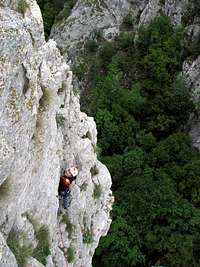-
 12253 Hits
12253 Hits
-
 89.39% Score
89.39% Score
-
 29 Votes
29 Votes
|
|
Area/Range |
|---|---|
|
|
48.61112°N / 20.83797°E |
|
|
Hiking, Trad Climbing, Sport Climbing, Bouldering, Aid Climbing |
|
|
Spring, Summer, Fall, Winter |
|
|
1312 ft / 400 m |
|
|
Slovak Karst - Slovensky Kras
The Slovak Karst is the most extensive and most developed karst area in Slovakia. It is located in the south-eastern part of the mountain ridge Slovenské Rudohorie, and covers an area of 34,611 ha, with a buffer zone around it of 11,741 ha. It penetrates into the districts of Rožňava (Rozsnyó) and Outer Košice (Kassa). The plateau-like area is divided by rivers into a system of plateaus with numerous above-ground and underground karst phenomena (such as lapiés, karren fields, karst holes, caves and abysses). Here are situated some of Slovakia’s best-known caves open to the public – Jasovská and Ochtinská aragonitová jaskyňa. The cave of Ochtínska, for instance, offers a unique display of underground karst with extraordinary decorations of clusters and bunches of milk-white aragonite, precious in terms of their mineralogy. Also of great interest is the Silická ľadnica – an abyss of a falling nature with permanent ice decoration. In 1995, 12 caves of the Slovak Karst were entered into the UNESCO list of World Cultural and Natural Heritage sites.The majority of the area of the national park is covered by deciduous forests with sessile oak and beech predominant. The area of the Slovak Karst is one of the richest botanical areas in Slovakia. Amongst others the Onosma tornensis, European dogtooth violet, Dianthus hungaricus and Arum alpinum all grow here. The diversity of fauna consists mainly of lower classes. Here can be found 130 species of mollusc, 1500 species of insect and 1022 species of butterfly. Bird species found here include the saker falcon, honey buzzard, the short-toed snake-eagle, the lesser spotted eagle, the Ural owl, the rufous-tailed rock-thrush and others. In 1977, the area of the Slovak Karst became the country’s first bio-reserve.
As well as natural beauties, the park also offers fascinating historical monuments such as the castle at Krásna Hôrka or the chateau of Betliar. Lovers of cycling, climbing, horse-riding, hunting, fishing or skiing will also find places to enjoy here. In short, it is a region that provides a range of memorable experiences for any eager tourist.
Zadielská Dolina - Szádelői-völgy
Zádiel (original Hungarian name is Szádelő) is a village 40km from Kosice (Kassa) and 4km from Torna in Slovak Karst (Slovensky Kras). It is united with Szádudvarnok and this new village called Zádielské Dvorniky.This village was called Zadeley in 1317. First part of name - Zad (Szád) - means opening and slot, the end part "eley" (elő) means "front of something". This name mentions the village is placed at the entrance of a steep walled valley.
This valley arose by poured caves and between the 3-400m height walls there is Blatnica-stream.
As the legend says son of Attila, the Hun Prince Denezik was fallen from his winged horse when goths chased him. His brother, Prince Ellak found the corpse and buried him here. He and his nation settled down here in the defence of surrounding hills. A stream here is named Szár-stream and the hills named Szár-hills are memories of Denezik, the fallen prince.
Red Tape
Climbing is allowed between 1st August to 1st March.Camping - accomodation
No camping is allowed. There is Zadielská Chata where you can book accomodation. You can find accomodation in the nearest villages as well.Getting there
You can go to Zádiel (Szádelő) from Kosice and Roznava. It is easy because you can go on 50 main road. You can also arrive from Hungary through Tornanádaska border station. The valley is well seen from further distances from the road.
Border is open in off season 8:00-17:00 (1st October - 30th April) and 8:00-20:00 in summer (1st May - 30th September). If you miss this border you can go to Hungary through Hidasnémeti or Bánréve border stations. These are non-stop... But thanks for European Union membership of Hungary and Slovakia you won't need to use any border stations soon.
At the entrance of Zadielska Dolina you can find a parking place for your car. In season you must pay 20SKK but in winter it is free of charge.
External links
Climbing routes in Zadielská Dolina:http://www.jamesak.sk/spr_zadi.htm
Weather forecast for Kosice region:
http://www.weatheronline.co.uk/Slovakia/Kosice.htm







